Peregrine falcons have swapped sea cliffs for the UK parliament and red-crowned parrots have left tropical forests in Mexico for the leafy neighbourhoods of Pasadena.
Cities all over the world have their own unique ecological concoctions created by mixing human settlements with wildlife. Coronavirus-induced lockdown is changing the daily rhythm of urban life, shining a light on emboldened animals that usually prefer to remain hidden.
Biologists and ecologists normally feel more at home studying remote jungles or inaccessible mountain tops, where “real” nature is. But as our planet gets covered with cities, more and more environments are being run by humans, who have become a super keystone species.
Q&A What is wild cities week?
Show
Hide
This week, the Guardian’s Age of Extinction site is looking at biodiversity in cities and urban areas around the world, shining a spotlight on the under-appreciated world of nature hidden among the highrises and busy roads.
Around 55% of the world’s population live in urban areas and that number is projected to rise to 68% by 2050. Nature’s role in the wellbeing and happiness of billions of people will be more important than ever. While urbanisation is a major driver of biodiversity loss, many conservationists and town planners are trying to make built-up areas more nature-friendly. The role of green spaces in urban areas has even been formalised in a draft UN agreement to halt and reverse biodiversity loss, often referred to as the Paris agreement for nature.
The Covid-19 outbreak has seen cities and towns across the world go into lockdown which has enabled wildlife such as wild boar, deer, monkeys, foxes and even lions to venture into territory previously dominated by humans. It has also offered us the chance to notice and appreciate the natural world in cities in an unprecedented way.
In this special series of reports we’ll be looking at how animals and plants adapt to city life, what to look out for right now and how we can encourage more wild cities in the future.
Cities are not mausoleums for nature but modern-day versions of the Galapagos archipelago, according to Menno Schilthuizen, author of Darwin Comes to Town, a book about contemporary evolution in cities where rapid changes can be observed within a human lifetime.

“Only in our flights of fancy can we still keep nature divorced from the human environment. Out in the real world, our tentacles entwine nature’s fabric,” Schilthuizen writes. “While we have been trying to save the world’s crumbling pre-urban ecosystems, we have been ignoring the fact that nature has already been putting up the scaffolds to build novel, urban ecosystems for the future.”
Haunting images of wolves, bison and bears living in deserted towns following the 1986 Chernobyl disaster indicate what happens when humans leave a place for good. The coronavirus lockdown shows how quickly wildlife closes in. “It is interesting to consider how fragile our urban environment is. If we’re not constantly present, it’s being taken over by nature very quickly,” says Schilthuizen, who is professor of evolutionary biology at Leiden University in the Netherlands.
The unique thing about coronavirus is that it is causing multiple cities across the globe to simultaneously go into hibernation. This gives ecologists an insight into how humans change urban biodiversity in multiple locations. “Animals are nearby, constantly watching us from the outskirts and the forests, and as soon as our presence seems to be abating they start exploring where new terrain could be won … It makes you aware of how we’re constantly competing with many species,” says Schilthuizen.
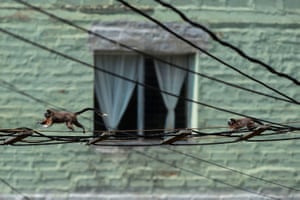
A messy business
Historically, urban environments have been seen as too contaminated by humans to teach us anything important about biodiversity. In the past few decades this has started to change but we still know little about the urban wildlife we live alongside, says Rana El-Sabaawi, associate professor of biology at Canada’s University of Victoria.
“If you look in the literature, the field of urban ecology doesn’t really come into its own until the last decade or two. Before that there were a smattering of papers and reports, mostly descriptions of biodiversity trends in and around specific cities. In recent years there has been a growing appreciation of the ecological mechanisms that explain biodiversity in the city,” she says.
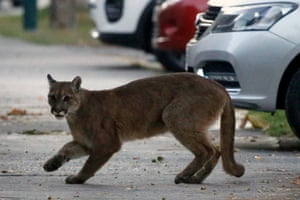
Urban environments are messy places (full of lights, pollution and people pursuing their own interests), which makes studying them difficult. It’s all very well to observe animals and plants in urban places, but understanding how these different processes fit together is more problematic.
At the same time, there is increasing recognition that few places on Earth are free from human influence – there is a plastic bag at the bottom of the Mariana Trench, and Antarctica’s remote glaciers are flecked with microplastics. Understanding places where humans interact with nature most should help planners and developers create cities that hold as much wildlife as possible.
Opportunists do well in cities
Broadly speaking, “sensitive” species, whose habitat is destroyed by urban developments, are unlikely to venture into urban areas. “Opportunists”, which have a much broader diet and high tolerance for noise and pollution, are more at home. Coronavirus means species that might lie in the grey area between these categories are now more likely to venture into previously unexplored urban areas.
Racoons, pigeons, foxes, gulls and crows are opportunists and considered a nuisance by many humans who live alongside them. Animals such as these, which scavenge human rubbish to get food, are likely to be struggling during lockdown.

Ring-necked parakeets might disperse away from urban parks and forage on agricultural land instead. Residents of the East Riding in Yorkshire have been warned seagulls could be more aggressive because there are fewer seaside day-trippers feeding them leftover chips. In Amsterdam, even coots – which sometimes line their nests with plastic – may have a tough time finding replacement materials.
“Often what happens when food supply runs short is increased competition and aggression between animals,” says El-Sabaawi. “There have already been fascinating reports from Asia about monkey ‘brawls’ caused by food shortages. If the food shortages are really severe and extended, then populations might decline.”
Other animals seem to be doing well with fewer people on the street. Urban songbirds, for example, can communicate more easily when the din of background traffic is reduced. Deer, badgers and wild boar might be emboldened to start pinching food from suburban gardens or roadsides. A herd of goats has been running riot through the Welsh town of Llandudno, munching on people’s gardens as they go.
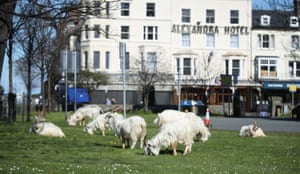
Most researchers are agreed these species’ corona-related behavioural changes are temporary and the luxury of living in town will stop when humans re-emerge. Lockdown will probably have a similar effect on wildlife populations as an exceptionally wet or hot year – provided things return to how they were.
In terms of wildlife sightings during this period, it’s hard to separate fact, fiction and wishful thinking – it’s a complex picture and new research is starting to try to make sense of what is happening. Scientists have launched a Silent Cities project to look at the diversity of sounds in places normally masked by anthropogenic noise. People are being encouraged to record sounds in “ordinary” suburban/urban spaces such as in a backyard or on a balcony during lockdown, and compare it to noises when things are back to normal.
Cities are also powerhouses for permanent changes. For example, there are distinct subspecies of mosquitoes found on the London underground that no longer hibernate and feed on human blood as opposed to bird blood, according to research published in Nature in 1999. Even more remarkable, mosquitoes living on different tube lines do not mix so the population living on the Circle line is genetically different to those living on the Piccadilly line. This change happened over 100 generations or so – significantly faster than Charles Darwin thought possible.
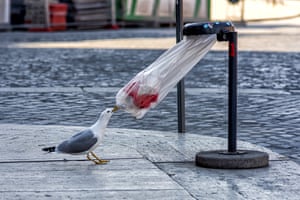
Urban blackbirds are also morphing into a new species, according to Schilthuizen. Across European and north African cities, blackbirds living in urban areas have developed shorter bills (probably thanks to an abundance of bird feeders and easier pickings in cities). Traffic noise has caused urban blackbirds to sing in the night when it’s quieter, and they also breed around a month earlier than their countryside cousins.
Scientists think the urban blackbird, Turdus urbanicus, could be the first of many species to adapt to life in the city. Schilthuizen writes: “The pace of evolution is set by ecological opportunities that emerge from human interactions … In those pressure cookers of environmental change, species will need to speed up their evolution or become extinct.”
Plants tell the history of our cities
Changes in botany have been massive in the past decade with huge shifts in wild plants living in urban areas, according to London-based botanist Dr Mark Spencer. “Plants have lived with us in our cities for thousands of years and they move along with us and they tell stories about us,” he says.
London is an important focal point for the arrival of non-native species in the UK, either arriving accidentally by international trade (via wool, for example) or escapees from domestic horticulture. Cities are the first pitstop for species that could later spread around the whole country.
For example, loquat (a common cousin of plums, cherries and apricots) is becoming established in London where Greek and Turkish communities typically live because people spit out the pips on the ground after they’ve eaten the fruit. And now it’s starting to sprout in the wild.

Widespread non-native plants such as Himalayan balsam, buddleia and Japanese knotweed were originally imported for horticulture. “The detailed research on the entry points of these well-established non-native species is not done,” says Spencer. “In this country, we have a focus on doing biological and ecological research on nice pristine chalk grasslands – which are wonderful habitats. We don’t like getting down and dirty with weird and wonderful street pavements. That’s pretty much it, putting it in crass terms. Urban areas are very poorly understood.”
Like animals, plants also adapt to city life. Crepis sancta, a widely spread Mediterranean member of the daisy family, has moved into Montpellier in France. In 12 years the seeds have evolved to be larger and heavier so they are more likely to fall into soil near their parent plant rather than on concrete which covers most of the city. Lighter seeds were 55% less likely to germinate, researchers found.
“Ordinary” urban areas are places we desperately need to understand, Spencer says. “A lot of this stuff is not about traipsing around recording hyper-rarities or incredible orchids, it’s about getting the common and the widespread.”
People sending in samples of species can help researchers collect more accurate records about changes in botany. “One of the things we’ve been trying to do for the past decade or so in natural history is get past this idea that it’s elite, purely expert, frankly old, white, male, grey tops that can do it, and no one else can. Actually, the only way you get past this is by supporting people,” says Spencer, who encourages people to submit plant sightings to i-record.
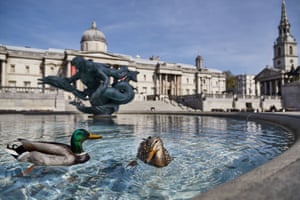
Will lockdown change how people interact with nature? Probably not, says Schilthuizen. “I’m enjoying the quiet. I keep thinking to myself, this is the way things should be, without constant air traffic overhead and without constant noise of traffic and throngs of people spending money on the streets … But I think we have a short memory. The bliss of a quiet period – or the memory of that period – will disappear quite quickly.”
Find more age of extinction coverage here, and follow biodiversity reporters Phoebe Weston and Patrick Greenfield on Twitter for all the latest news and features